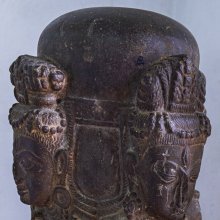Aghora: 22 definitions
Introduction:
Aghora means something in Hinduism, Sanskrit, Marathi. If you want to know the exact meaning, history, etymology or English translation of this term then check out the descriptions on this page. Add your comment or reference to a book if you want to contribute to this summary article.
Aghora has 21 English definitions available.
Images (photo gallery)
Languages of India and abroad
Sanskrit dictionary
[Deutsch Wörterbuch]
Source: Cologne Digital Sanskrit Dictionaries: Böhtlingk and Roth Grosses Petersburger WörterbuchAghora (अघोर):—(3. a + ghora)
1) adj. f. ā nicht schreckend, nicht verderblich: aghoreṇa.cakṣuṣā mi.riyeṇa [Atharvavedasaṃhitā 7, 60, 1]; vgl. aghoracakṣus. yā te rudra śivā tanūraghorā [ŚVETĀŚV. Upakośā 3, 5.] —
2) m. ein Beiname Śiva’s: iti śivacaturdaśīvratapūjāyām [Śabdakalpadruma]; vgl. aghoraghorarūpa und ghoraghoratara . —
3) f. rā der 14te Tag in der dunkeln Hälfte des Monats Bhādra: bhādramāsyasite pakṣe ghorākhyā (lies agho) caturdaśī . tasyāmārādhitaḥ sthāṇurnayecchivapuraṃ dhruvam .. eine Smṛti im [Śabdakalpadruma]
--- OR ---
Aghora (अघोर):—
1) [Oxforder Handschriften 88,b,27.] —
2) vgl. [WILSON, Sel. Works 2, 215.] aghorarudrotpatti [Oxforder Handschriften 44,b,15.] aghorotpattāvaghorajapaḥ [16.] mantrapūjāvidhi [45,a,23.] māhātmya [28.] aghorāstra [106,a,30.]
Source: Cologne Digital Sanskrit Dictionaries: Sanskrit-Wörterbuch in kürzerer FassungAghora (अघोर):——
1) Adj. nicht grausig. —
2) m. eine Form Śiva's. —
3) f. ā der 14te Tag in der dunklen Hälfte des Monats Bhādra.
Sanskrit, also spelled संस्कृतम् (saṃskṛtam), is an ancient language of India commonly seen as the grandmother of the Indo-European language family (even English!). Closely allied with Prakrit and Pali, Sanskrit is more exhaustive in both grammar and terms and has the most extensive collection of literature in the world, greatly surpassing its sister-languages Greek and Latin.
See also (Relevant definitions)
Starts with (+13): Aghorabhairavamurti, Aghorabija, Aghorabijamantra, Aghoracakshus, Aghoragama, Aghoraghanta, Aghoraghorarupa, Aghoraghoratara, Aghorakalpa, Aghoramantra, Aghoramantrasadhanaprakara, Aghoramarga, Aghoramurti, Aghoranaraka, Aghoranayika, Aghoranilakanthamantra, Aghorapamthiya, Aghorapancanga, Aghorapantha, Aghorapanthi.
Ends with: Ghanaghora, Mahaghora, Nilaghora, Shataghora, Vaghora, Vikataghora.
Full-text (+117): Aghoracakshus, Aghorapatha, Aghoramarga, Aghorapathin, Aghoraghorarupa, Pancabrahma, Pancanana, Pancavaktra, Vijayagama, Sadashiva, Aghori, Agghor, Sattvahina, Ghorahridaya, Krishnakalpa, Aghorapramana, Vyadhibhakshini, Nishvasagama, Analagama, Viragama.
Relevant text
Search found 35 books and stories containing Aghora, Aghorā, Aghōra; (plurals include: Aghoras, Aghorās, Aghōras). You can also click to the full overview containing English textual excerpts. Below are direct links for the most relevant articles:
The Linga Purana (by J. L. Shastri)
Chapter 26 - The mode of worshipping Aghora < [Section 2 - Pūrvabhāga]
Chapter 27 - The description of the Jaya ablution < [Section 2 - Pūrvabhāga]
Chapter 14 - Origin of Aghora < [Section 1 - Uttarabhāga]
The Agni Purana (by N. Gangadharan)
Chapter 146 - Names of different Goddesses
Chapter 315 - Narration of mantras relating to paralysing, captivating etc.
Chapter 324 - Appeasing rite for lord Śiva (rudraśānti or śivaśānti)
The Shiva Purana (by J. L. Shastri)
Appendix 1 - The five faces of Śiva (pañcānana) < [Appendices]
Chapter 3 - Upamanyu’s advice to lord Kṛṣṇa < [Section 7.2 - Vāyavīya-saṃhitā (2)]
Chapter 1 - The five incarnations of the supreme Brahman < [Section 3 - Śatarudra-saṃhitā]
Rudra-Shiva concept (Study) (by Maumita Bhattacharjee)
40. Pañcabrahma incarnation < [Chapter 5 - Rudra-Śiva in the Purāṇic Literature]
2.35. Śiva as Pañcānana < [Chapter 6a - The Epithets of Rudra-Śiva]
3. Epithets of Rudra-Śiva tracked in the Āraṇyaka literature < [Chapter 6b - Epithets (References)]
Shaiva Upanishads (A Critical Study) (by Arpita Chakraborty)
17. The esoteric significance of Five Faces of Lord Śiva < [Chapter 5 - Essence of Pañcabrahma Upaniṣad]
3. The form of Aghora < [Chapter 5 - Essence of Pañcabrahma Upaniṣad]
13. Forms are for Visualization < [Chapter 5 - Essence of Pañcabrahma Upaniṣad]
The Skanda Purana (by G. V. Tagare)
Chapter 301 - Greatness of Siddheśvara (Siddha-īśvara) < [Section 1 - Prabhāsa-kṣetra-māhātmya]
Chapter 92 - Greatness of Aghoreśvara (Aghora-īśvara) < [Section 1 - Prabhāsa-kṣetra-māhātmya]
Chapter 169 - Greatness of Vaivasvateśvara (Vaivasvata-īśvara) < [Section 1 - Prabhāsa-kṣetra-māhātmya]
Related products

